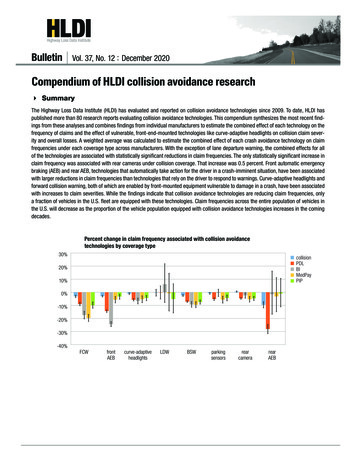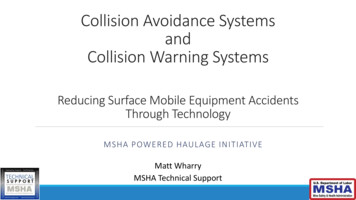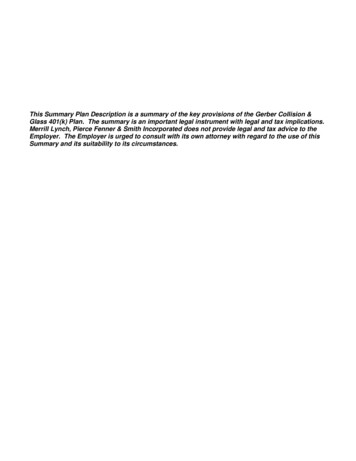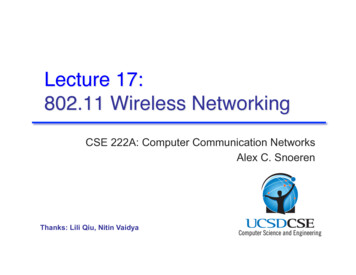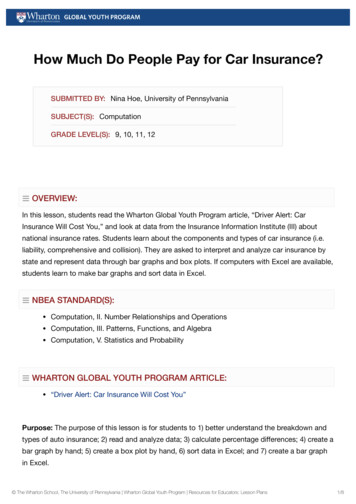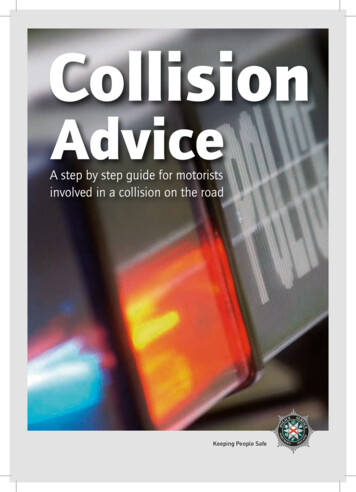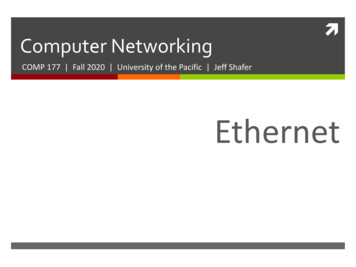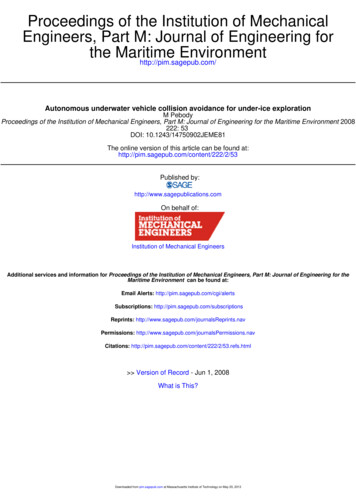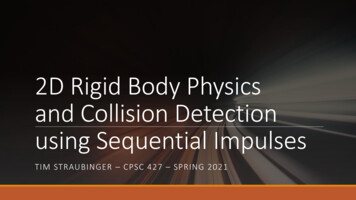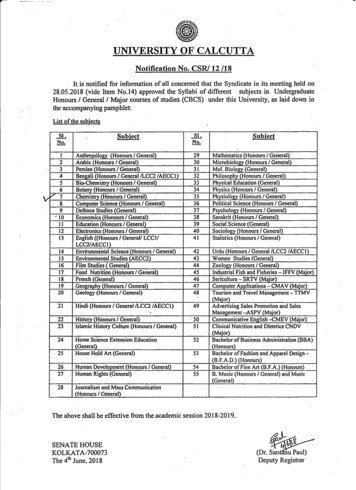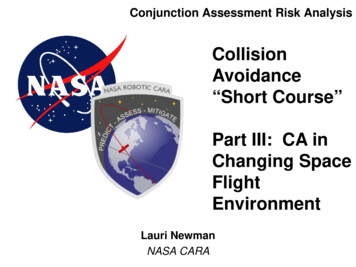
Transcription
Conjunction Assessment Risk AnalysisCollisionAvoidance“Short Course”Part III: CA inChanging SpaceFlightEnvironmentLauri NewmanNASA CARA
Changing Space Environment Space environment has been changing, and will continue to evolverapidly over the next few years due to the following drivers:– Space Fence– Large constellations– New Space Actors– Smallsat proliferation CA practices will need to evolve to meet growing needs– New Methodologies– Best Practices– Orbital Registry– Data Sharing Space Traffic Management– Recent updatesNASA/CNES CA Short Course SEP 2018 2
S-Band Fence:Problem/Study Definition New Space Surveillance Network (SSN) sensor expected toincrease catalog size significantly– Equatorial phased-array S-Band sensor– Can track to better than 5 cm (SSN capability 10 cm)– Initial Operations Capability currently planned for summer 2019 Expected issues for CA– Vastly increased quantity of new objects– Quality of maintenance ODs Newly-discovered objects likely to receive light tracking May create additional ops ambiguities and affect event actionability– If new workload is too large, current CA operations paradigm might need tobe adjustedNASA/CNES CA Short Course SEP 2018 3
S-Band Fence:Study Composition / Timeline CARA spearheaded collaborative study among the following organizations:– S-Band Fence SPO (AFLCMC; Hanscom AFB), including Lockheed Martin(development contractor)– NASA/JSC (TOPO/FDO) and /ODPO– AF Space Command / A5– The Aerospace Corporation– USSTRATCOM, including CSpOC/18 SPCS and Dahlgren (Det 1)– FAA CARA as analysis lead, with support from other organizations Purpose to determine additional workload imputed by SF deployment– Number of conjunctions expected per day– Number of serious events per day– If necessary, spin-off effort to develop new CA paradigmsNASA/CNES CA Short Course SEP 2018 4
S-Band Fence Study:Results Overall number of conjunction reports per day expected to increase byabout a factor of 3– Depends on Orbit altitude – varies between 2x and 4x This value not so large that new CA paradigms required– Some adjustment to thresholds and timelines; but existing algorithm set cancontinue to be used Results expected to be publically released in paper at AIAA Conferencein Maui in January 2019 Once data flows, will check actual workload and data quality againstsimulated resultsNASA/CNES CA Short Course SEP 2018 5
Increasing WorkloadUnique Events within 0.5x5x5-km Volume by Object Type, LEOPredicted Tracked Object Density by Altitude in 2030900250with LLCs SpaceFencespatial density (#/ 10 9 km 3)Business-as-usual(no LLCs)150100500200700# of Events/Monthwith LLCs currenttracking200800All Secondary ObjectsAll Debris ObjectsFengyun 1-C DebrisIridium-33/Cosmos-2251 DebrisDMSP 5D-2 F13 DebrisNOAA 16 ude (km)12001400160018000Sep05 Mar06 Sep06 Mar07 Sep07 Mar08 Sep08 Mar09 Sep09 Mar10 Sep10 Mar11 Sep11 Mar12 Sep12 Mar13 Sep13 Mar14 Sep14 Mar15 Sep15 Mar16 Sep16 Mar17 Sep17 Mar18 Current CA workload is large and expected to grow– Across the LEO fleet, NASA CARA sees about 700 unique conjunctions eachmonth– About one conjunction per month per LEO spacecraft requires further analysis andmitigation planning Requires 1 staff week of work for the CARA team for risk assessment as wellas support from the mission flight operations team for maneuver planning Only about 15% of analyzed events result in a maneuverNASA/CNES CA Short Course SEP 2018 6
Large ConstellationsSome Planned LEO ConstellationsOperator Planned large constellationswill add thousands ofobjects to catalog– Analysis of some proposedconstellations has indicated afresh conjunction event every 3days vs 1-2 fresh events/monthin current operations Operations impact is large– Effort to analyze the data willrequire more manpower– Hopefully the development ofrobust automated riskassessment tools will follow toreduce operations impactSpaceX V-bandPlanet SwiftCapellaNum satsAlt (km)Country7518335-345US60450US648Black SkyKepler140Skybox30YaliniSpirePlanet DovesOrbcomm13510015031IridiumTheiaLucky StarTelesat LEOBoeing72112SpaceX StarlinkOneWebTelesat LEOBoeingLeoSatAstrome SUSUSCourtesy of TheAerospaceCorporationNASA/CNESCAShort Course SEP 2018 7
New Space Actors The space environment today is very different from what it was 10years ago and continues to evolve with technology– Historically, space operations were domain of large governmental entities.– Commercial space operators are becoming commonplace and have differentbusiness models than government actors– Cubesats are cost effective and accessible for everyone down to elementaryschools Challenge in educating new space actors on best practices andavailability of data and toolsNASA/CNES CA Short Course SEP 2018 8
New Methodologies Potential new CA paradigms to handle workload– CA remediation against “grouped” events using an aggregate Pc– Station-keeping burn strategy to minimize conjunction risk, without actuallyremediating individual events unless an extremely high Pc– Consideration of consequence in addition to risk to determine which events toremediate Automation/artificial intelligence– Investigate methods to automate more of the process Ensure that maneuvers are screened before performing OD must be verified and new tracking requested– Determine usefulness of machine learning, neural nets, etc. in decisionmakingNASA/CNES CA Short Course SEP 2018 9
Best Practices CA industry is evolving rapidly– Guidelines/standards are needed to enable healthy growth New methodologies will be needed for safety of flight– Safety of Flight best practices should be adapted universally Best practices are available on Space-Track.org website Secure World Foundation publishes “Handbook for New Actors in Space” NASA CARA to publish CA Handbook as well; focus will be more ontechnical/scientific foundations of best practices– Existing operators can share experience and lessons learnedNASA/CNES CA Short Course SEP 2018 10
Orbital Registry Propose an “Orbital Registry” service as part of STM that would:– Deconflict orbital placement: provide evaluation of mission orbit selectionduring design phase to determine impact from close approach perspective andoffer trade space of alternative orbits Similar to filing flight plans; during license evaluation is too late to change orbitselection – should be during design– Tweaking orbits by a few km can make a big difference in reducing thenumber of close approaches with neighbors Allows for advance notice of potential co-locations so that they can be avoidedor managed smartly.– Maintain database of operator contact information– Enable protected data sharing: Sharing ephemerides is critical for poweredflight/low-thrust modelling. Operators need to be ensured that their sensitive datais protected. Centralized screening service would allow trusted agent to do this screeningwhile keeping data secure– Provide access to best practices/guidelines Initial best practices available include Space-Track.org, Secure WorldFoundation Handbook for New Space ActorsNASA/CNES CA Short Course SEP 2018 11
Importance of Data Sharing Many spacecraft now using electric propulsion and/or automatedonboard maneuver planning and execution– The currently-maintained RSO catalog won’t have up-to-date data on where theseobjects are These missions will need to share powered flight ephemerides toall for CA– Other operators have no way to tell where these assets are without shared data– Users would have to change their practice to screen these ephemerides againsttheir own instead of relying solely on CSpOC/18 SPCS– Sharing should be through a trusted/protected mechanism, like Space-Track.org orSDA.– Missions will have to have mechanism for screening these ephemerides Issue– How does an operator know that another operator exists, or know where to findephemeris data for other assets?NASA/CNES CA Short Course SEP 2018 12
Space Traffic Management [1 of 2] The potential need for a Space Traffic ManagementArchitecture has been the subject of debate internationallyfor several years.– Need for rules of the road to help operators efficiently use space National Space Council– Re-established in June 2017 by President– Created interagency working group to look at STM issue Space Policy Directive-3– Signed June 18, 2018 by President at 3rd NSpC meeting– First US Space Traffic Management Policy– Department of Commerce will make space safety data and servicesavailable to the public– Department of Defense will continue to maintain the authoritativecatalogue of space objects– Implementation plan still being workedNASA/CNES CA Short Course SEP 2018 13
Space Traffic Management [2 of 2] American Space SAFE (Situational Awareness and Facilitation ofEntity) Management Act– Approved by U.S. House Science, Space, and Technology Committee on June 27, 2018– This bill will establish the Department of Commerce as the civilian agency to provide civilspace situational awareness and traffic coordination. Further, the act: Directs NASA to develop a plan for science and technology R&D activities to improvespace situational awareness (SSA) and space traffic coordination capabilities Establishes a NASA Center of Civil Space Situational Awareness Science andTechnology Excellence Establishes a civilian Space Situational Awareness Program at the Department ofCommerce to provide information and services to spacecraft operators Requires a basic set of SSA information and services for no charge and allows feesfor additional information and services Promotes opportunities for U.S. private sector SSA data and service providers toparticipate in and contribute to the Program Establishes an SSA data testbed to provide public access to certain SSA data Provides for NASA technical expertise to be leveraged by the Department ofCommerce on a reimbursable basis Directs the Secretary of Commerce to develop voluntary civil space traffic coordinationguidelines and facilitate the development of industry standards Creates a five-year space traffic coordination pilot program at the Department ofCommerce to facilitate communication, negotiation, and resolution by civil spacecraftoperatorsNASA/CNES CA Short Course SEP 2018 14
Summary Exciting growth offers opportunities that will change society, butneeds to be done safely to ensure that we have continued use of thespace environment for future generations References:– The Aerospace Corporation, “Space Traffic Management In The Age of NewSpace” SpaceTrafficMgmt 0.pdfNASA/CNES CA Short Course SEP 2018 15
Iridium-33/Cosmos-2251 Debris DMSP 5D-2 F13 Debris NOAA 16 Debris Analysts. Predicted Tracked Object Density by Altitude in 2030. 0. 50. 100. 150. 200. 250 200. 400. 600. 800. 1000. 1200. 1400. 1600. 1800. spatial density (#/ 10 9 km 3) altitude (km) with LLCs Space Fence with LLCs current tracking. Business-as-usual (no LLCs) # of Events/Month
